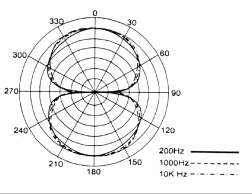Polar response is the measurement of a microphone's sensitivity to a given frequency relative to angle of incidence. Ribbons naturally exhibit a bidirectional, or figure-of-8 polar response because both sides of the transducer are equally exposed to incoming sound pressure waves. This means the microphone exhibits equal sensitivity to sounds arriving at the front as it does to those at the rear. This may lead you to conclude that a ribbon should exhibit an omnidirectional polar pattern. However, sound pressure waves arriving at the rear of the transducer are electrically 180 degrees out-of-phase at the output with those arriving at the front. If we draw an imaginary line down the center of the transducer, the microphone's axis, sounds arriving at the side of the transducer ("the null point," 90 degrees off-axis) produce equal but opposite sound pressure on both sides of the ribbon. As both sides are 180 degrees out-of-phase with each other, output at both null points is zero, resulting in a polar pattern that resembles the number 8 (fig. 2), hence the name of the pattern. Ribbons exhibit the truest bidirectional polar response, and feature absolute null-point rejection, opening up a world of mic placement possibilities.
Some multipattern condenser microphones are capable of producing a bidirectional pattern, but to accomplish this they must use complex active electronics which can impart noise, distortion, and undesirable off-axis artifacts. Accordingly, ribbon mics that feature unidirectional (cardioid, supercardioid, or hypercardioid) polar response must also create patterns electronically or mechanically to overcome the ribbon's natural physical state. As we will learn in the next section, there are some serious advantages to using true bidirectional mics in studio and on stage.
Fig. 2 - bidirectional polar pattern

